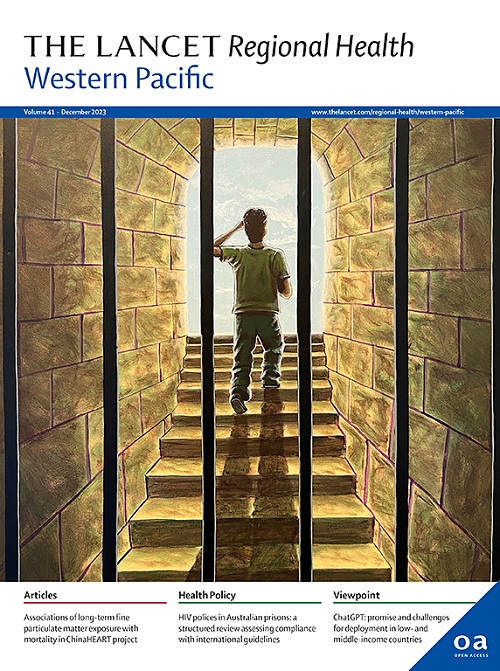Quantifying the contributions of cardiovascular risk factors to cardiovascular disease trends in 21st century Japan: a microsimulation study
IF 8.1
1区 医学
Q1 HEALTH CARE SCIENCES & SERVICES
引用次数: 0
Abstract
Background
Recent stagnation or worsening trends in cardiovascular disease (CVD) risk factors, including low-density lipoprotein cholesterol (LDL-c) and obesity, might slow the decline in Japan's CVD burden. We aimed to quantify the impact of national changes in CVD risk factor distributions on Japan's CVD burden from 2001 to 2019.
Methods
We conducted a microsimulation study with counterfactual analysis using IMPACTNCD-JPN, a validated model based on real-world data. It simulated a synthetic Japanese population (ages 30–99) from 2001 to 2019 using life-course data on seven CVD risk factors, estimating CVD incidence, mortality, and healthcare economics for synthetic individuals. The base-case reflected observed trends; counterfactual scenarios assumed 2001 levels persisted. Primary outcome was national CVD incidence (stroke and coronary heart disease).
Findings
From 2001 to 2019, systolic blood pressure (SBP) and smoking declined markedly (men/women) by 6·8/7·2 mmHg and 18·4/6·8%, respectively, while LDL-c, HbA1c, body mass index (BMI), physical activity (PA), and fruit/vegetable (FV) consumption showed smaller or adverse trends. Under the base-case and counterfactual scenarios, IMPACTNCD-JPN estimated CVD incidence and quantified the differences between the scenarios. The changes in the CVD risk factors prevented or postponed 840,000 (95% uncertainty interval: 540,000–1,300,000) national CVD cases, cumulative from 2001 to 2019. Individual contributions were: SBP 540,000; smoking 280,000; LDL-c 27,000; HbA1c 7900; BMI −15,000; PA −16,000; and FV consumption −11,000.
Interpretation
SBP and smoking reductions drove most CVD burden declines in Japan (2001–2019). Modest benefits came from LDL-c and HbA1c, while rising BMI, and low PA and FV intake partly offset these benefits.
Funding
JSPS KAKENHI JP22K17821, JP25K02863; the Ministry of Health, Labour and Welfare Comprehensive Research on Life-Style Related 22FA1015, 24FA1015.
量化心血管危险因素对21世纪日本心血管疾病趋势的贡献:一项微观模拟研究
背景:最近心血管疾病(CVD)危险因素(包括低密度脂蛋白胆固醇(LDL-c)和肥胖)的停滞或恶化趋势可能会减缓日本CVD负担的下降。我们旨在量化2001年至2019年日本心血管疾病风险因素分布的国家变化对心血管疾病负担的影响。方法采用基于真实数据的验证模型IMPACTNCD-JPN进行微观模拟研究,并进行反事实分析。该研究利用7个心血管疾病风险因素的生命历程数据,模拟了2001年至2019年的日本合成人群(30-99岁),估计了合成个体的心血管疾病发病率、死亡率和医疗保健经济学。基本情况反映了观察到的趋势;反事实情景假设2001年的水平持续存在。主要终点是全国CVD发病率(中风和冠心病)。从2001年到2019年,收缩压(SBP)和吸烟率(男性/女性)分别显著下降了6.8 / 7.2 mmHg和18.4 / 6.8%,而LDL-c、HbA1c、体重指数(BMI)、体力活动(PA)和水果/蔬菜(FV)消费量则呈现较小或不利的趋势。在基本情景和反事实情景下,IMPACTNCD-JPN估算了CVD发生率,并量化了情景之间的差异。心血管疾病危险因素的变化预防或推迟了840,000例(95%不确定区间:540,000-1,300,000)全国心血管疾病病例,累计从2001年到2019年。个人捐款为:54万SBP;吸烟280000;低密度27000;糖化血红蛋白7900;BMI−15000;PA−16000;FV消耗−11000。2001-2019年,日本心血管疾病负担下降的主要原因是血压和吸烟的减少。LDL-c和HbA1c有一定的益处,而BMI上升、PA和FV摄入量降低部分抵消了这些益处。jpsps KAKENHI JP22K17821, JP25K02863;厚生劳动省生活方式相关综合研究22FA1015, 24FA1015。
本文章由计算机程序翻译,如有差异,请以英文原文为准。
求助全文
约1分钟内获得全文
求助全文
来源期刊

The Lancet Regional Health: Western Pacific
Medicine-Pediatrics, Perinatology and Child Health
CiteScore
8.80
自引率
2.80%
发文量
305
审稿时长
11 weeks
期刊介绍:
The Lancet Regional Health – Western Pacific, a gold open access journal, is an integral part of The Lancet's global initiative advocating for healthcare quality and access worldwide. It aims to advance clinical practice and health policy in the Western Pacific region, contributing to enhanced health outcomes. The journal publishes high-quality original research shedding light on clinical practice and health policy in the region. It also includes reviews, commentaries, and opinion pieces covering diverse regional health topics, such as infectious diseases, non-communicable diseases, child and adolescent health, maternal and reproductive health, aging health, mental health, the health workforce and systems, and health policy.
 求助内容:
求助内容: 应助结果提醒方式:
应助结果提醒方式:


